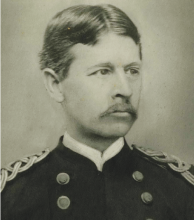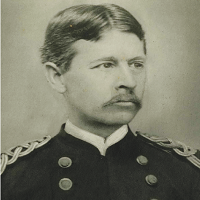User login
Walter Reed National Military Medical Center in Bethesda, Maryland, is one of several military and civilian medical facilities named for a U.S. Army doctor.
Walter Reed, MD, was born September 13, 1851 near Gloucester on Virginia’s middle peninsula. His father was the pastor of the Bellamy Methodist Church. The Reed family frequently moved as was required by the church and thus lived in many areas of southeastern Virginia and North Carolina. After the Civil War, Reverend Reed moved his family to Charlottesville, Virginia, where Walter, 15, and 2 of his older brothers were enrolled in the University of Virginia.
After a successful year of study, Reed summoned enough courage to confront the formidably bearded elders of the medical faculty with a bold proposal: If he passed all the courses, would they award him a medical degree regardless of the time it took or his age when he finished? A little more than 2 months shy of this 18th birthday, Reed graduated standing third in a class of 10 remaining from the original 50. He was, then and now, the youngest person ever to graduate from the University of Virginia School of Medicine. Reed went to Bellevue Hospital Medical School in New York for clinical hospital training. In another year, he earned his second medical degree, though it was not awarded until after he had reached the ripe old age of 21.
Reed joined the U.S. Army in 1875, possibly looking for a secure position that allowed him to marry his sweetheart Emily Lawrence in 1876. Over the first 18 years of marriage, they moved about 15 times throughout the west with some eastern assignments.
The selection of George Miller Steinberg as Army Surgeon General in 1893 turned out to be a watershed in Reed’s career. He joined the faculty of the new Army medical school. Reed lived closer to Washington (Minnesota) than did the other candidate (California), which probably helped his candidacy. Reed took full advantage of this opportunity and became a trusted troubleshooter for Sternberg.
After the Spanish-American War, Reed led a U.S. Army board that investigated typhoid fever in stateside camps, which killed more soldiers than died on the battlefield during the war. The findings of this board alone would have made Reed famous, but before these findings were formally published, Reed was sent to Cuba to lead another U.S. Army board to investigate infectious diseases, including yellow fever. Over the course of a few months, with the input and assistance of many others, he designed and carried out a series of human experiments that proved the mosquito as the vector of yellow fever. Application of his findings quickly led to the control of yellow fever in Cuba and later in Panama and throughout the tropics.
Reed died in Washington, DC, in 1902 at age 51, following surgery that discovered a ruptured appendix, which in that pre-antibiotic era was nearly always fatal. William Borden, his surgeon and friend, campaigned for several years for a new U.S. Army hospital in Washington to be named for Reed. Borden was successful with the opening of Walter Reed Army General Hospital in 1909. Renamed Walter Reed Army Medical Center in 1951 on the 100th anniversary of Reed’s birth, the hospital was closed in 2011 and its name transferred to the new Walter Reed National Military Medical Center. Other facilities named for Reed include the Walter Reed Army Institute of Research in Maryland and the civilian Riverside Walter Reed Hospital in Gloucester Courthouse, Virginia.
A particularly interesting resource to learn more about Reed is the Philip Hench Walter Reed Yellow Fever Collection. Most of the collection is available online (http://yellowfever.lib.virginia.edu/reed).
Walter Reed National Military Medical Center in Bethesda, Maryland, is one of several military and civilian medical facilities named for a U.S. Army doctor.
Walter Reed, MD, was born September 13, 1851 near Gloucester on Virginia’s middle peninsula. His father was the pastor of the Bellamy Methodist Church. The Reed family frequently moved as was required by the church and thus lived in many areas of southeastern Virginia and North Carolina. After the Civil War, Reverend Reed moved his family to Charlottesville, Virginia, where Walter, 15, and 2 of his older brothers were enrolled in the University of Virginia.
After a successful year of study, Reed summoned enough courage to confront the formidably bearded elders of the medical faculty with a bold proposal: If he passed all the courses, would they award him a medical degree regardless of the time it took or his age when he finished? A little more than 2 months shy of this 18th birthday, Reed graduated standing third in a class of 10 remaining from the original 50. He was, then and now, the youngest person ever to graduate from the University of Virginia School of Medicine. Reed went to Bellevue Hospital Medical School in New York for clinical hospital training. In another year, he earned his second medical degree, though it was not awarded until after he had reached the ripe old age of 21.
Reed joined the U.S. Army in 1875, possibly looking for a secure position that allowed him to marry his sweetheart Emily Lawrence in 1876. Over the first 18 years of marriage, they moved about 15 times throughout the west with some eastern assignments.
The selection of George Miller Steinberg as Army Surgeon General in 1893 turned out to be a watershed in Reed’s career. He joined the faculty of the new Army medical school. Reed lived closer to Washington (Minnesota) than did the other candidate (California), which probably helped his candidacy. Reed took full advantage of this opportunity and became a trusted troubleshooter for Sternberg.
After the Spanish-American War, Reed led a U.S. Army board that investigated typhoid fever in stateside camps, which killed more soldiers than died on the battlefield during the war. The findings of this board alone would have made Reed famous, but before these findings were formally published, Reed was sent to Cuba to lead another U.S. Army board to investigate infectious diseases, including yellow fever. Over the course of a few months, with the input and assistance of many others, he designed and carried out a series of human experiments that proved the mosquito as the vector of yellow fever. Application of his findings quickly led to the control of yellow fever in Cuba and later in Panama and throughout the tropics.
Reed died in Washington, DC, in 1902 at age 51, following surgery that discovered a ruptured appendix, which in that pre-antibiotic era was nearly always fatal. William Borden, his surgeon and friend, campaigned for several years for a new U.S. Army hospital in Washington to be named for Reed. Borden was successful with the opening of Walter Reed Army General Hospital in 1909. Renamed Walter Reed Army Medical Center in 1951 on the 100th anniversary of Reed’s birth, the hospital was closed in 2011 and its name transferred to the new Walter Reed National Military Medical Center. Other facilities named for Reed include the Walter Reed Army Institute of Research in Maryland and the civilian Riverside Walter Reed Hospital in Gloucester Courthouse, Virginia.
A particularly interesting resource to learn more about Reed is the Philip Hench Walter Reed Yellow Fever Collection. Most of the collection is available online (http://yellowfever.lib.virginia.edu/reed).
Walter Reed National Military Medical Center in Bethesda, Maryland, is one of several military and civilian medical facilities named for a U.S. Army doctor.
Walter Reed, MD, was born September 13, 1851 near Gloucester on Virginia’s middle peninsula. His father was the pastor of the Bellamy Methodist Church. The Reed family frequently moved as was required by the church and thus lived in many areas of southeastern Virginia and North Carolina. After the Civil War, Reverend Reed moved his family to Charlottesville, Virginia, where Walter, 15, and 2 of his older brothers were enrolled in the University of Virginia.
After a successful year of study, Reed summoned enough courage to confront the formidably bearded elders of the medical faculty with a bold proposal: If he passed all the courses, would they award him a medical degree regardless of the time it took or his age when he finished? A little more than 2 months shy of this 18th birthday, Reed graduated standing third in a class of 10 remaining from the original 50. He was, then and now, the youngest person ever to graduate from the University of Virginia School of Medicine. Reed went to Bellevue Hospital Medical School in New York for clinical hospital training. In another year, he earned his second medical degree, though it was not awarded until after he had reached the ripe old age of 21.
Reed joined the U.S. Army in 1875, possibly looking for a secure position that allowed him to marry his sweetheart Emily Lawrence in 1876. Over the first 18 years of marriage, they moved about 15 times throughout the west with some eastern assignments.
The selection of George Miller Steinberg as Army Surgeon General in 1893 turned out to be a watershed in Reed’s career. He joined the faculty of the new Army medical school. Reed lived closer to Washington (Minnesota) than did the other candidate (California), which probably helped his candidacy. Reed took full advantage of this opportunity and became a trusted troubleshooter for Sternberg.
After the Spanish-American War, Reed led a U.S. Army board that investigated typhoid fever in stateside camps, which killed more soldiers than died on the battlefield during the war. The findings of this board alone would have made Reed famous, but before these findings were formally published, Reed was sent to Cuba to lead another U.S. Army board to investigate infectious diseases, including yellow fever. Over the course of a few months, with the input and assistance of many others, he designed and carried out a series of human experiments that proved the mosquito as the vector of yellow fever. Application of his findings quickly led to the control of yellow fever in Cuba and later in Panama and throughout the tropics.
Reed died in Washington, DC, in 1902 at age 51, following surgery that discovered a ruptured appendix, which in that pre-antibiotic era was nearly always fatal. William Borden, his surgeon and friend, campaigned for several years for a new U.S. Army hospital in Washington to be named for Reed. Borden was successful with the opening of Walter Reed Army General Hospital in 1909. Renamed Walter Reed Army Medical Center in 1951 on the 100th anniversary of Reed’s birth, the hospital was closed in 2011 and its name transferred to the new Walter Reed National Military Medical Center. Other facilities named for Reed include the Walter Reed Army Institute of Research in Maryland and the civilian Riverside Walter Reed Hospital in Gloucester Courthouse, Virginia.
A particularly interesting resource to learn more about Reed is the Philip Hench Walter Reed Yellow Fever Collection. Most of the collection is available online (http://yellowfever.lib.virginia.edu/reed).

